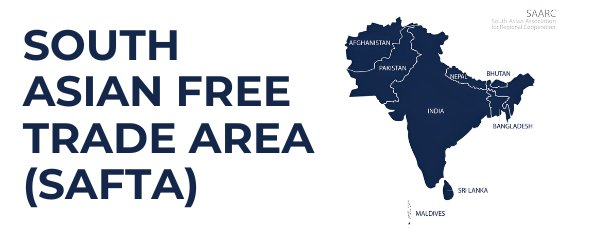Important Facts For Prelims
Edible Oil Imports and SAFTA Agreement
- 11 Feb 2025
- 5 min read
Why in News?
The Solvent Extractors’ Association of India (SEA) has raised concerns over the massive influx of refined Edible Oil (soybean and palm) from Nepal to India, citing a misuse of the South Asian Free Trade Area (SAFTA) agreement’s duty-free import provisions.
Note: Established in 1963, SEA represents India’s solvent extraction industry, including processors, exporters, refiners, and traders. It operates independently as a private body.
- Solvent extraction is a method to separate compounds based on their relative solubilities in two different immiscible liquids.
What is the Edible Oil Scenario in India’s Economy?
- Edible Oil and Oil Seeds: India, one of the largest oilseed producers, contributes 5-6% to global production, with an estimated 39.66 million tonnes in 2023-24.
- Major oilseeds include Groundnut, Soybean, Sunflower, Mustard, Sesame, Niger, and Safflower.
- India's vegetable oil economy is the world's fourth largest after the USA, China and Brazil.
- The edible oil industry contributes significantly to agriculture and trade, with oilseed and oil meal exports valued at Rs 29,587 crore in 2023-24.
- In 2022-23, India imported 16.5 million tonnes (MT) of edible oils, with domestic production fulfilling only 40-45% of the country’s requirements, relying on imports for 57% of consumption.
- Major Edible Oils in India:
- Traditional oils: Groundnut, mustard/rapeseed, sesame, safflower, linseed, niger seed, castor, Soybean, and sunflower.
- Plantation-based oils: Coconut, oil palm (grown in Andhra Pradesh, Karnataka, Tamil Nadu, Kerala, Andaman and Nicobar).
- Non-conventional oils: Rice bran oil, cottonseed oil.
- Forest-based oils: Collected from tree and forest sources, mainly in tribal regions.
- Government Initiatives: The country aims to reduce import dependency through initiatives like the National Mission on Oilseeds and Oil Palm (NMOOP), aiming to boost oilseed production from 39 to 69.7 million tonnes by 2030-31, meeting 72% of edible oil demand.
- Concerns: SEA is concerned about rising refined edible oil imports from Nepal, after India raised import duties on edible oils in 2024, Nepalese refiners started importing large amounts of crude oil and exporting refined oil to India at lower prices through SAFTA impacting Indian refiners and oilseed farmers.
- SEA Recommendations: India should restrict duty-free edible oil imports from SAFTA nations that don't produce oilseeds and amend SAFTA to prevent agro-commodity dumping.
- Introduce a Minimum Import Price (MIP) (protects farmers from predatory import pricing) based on the Minimum Support Price (MSP) of oilseeds.
South Asian Free Trade Area (SAFTA)
- About: SAFTA is the free trade arrangement of the South Asian Association for Regional Cooperation (SAARC).
- Came into force in 2006, succeeding the 1993 SAARC Preferential Trading Arrangement.
- Members: Afghanistan, Bangladesh, Bhutan, India, Maldives, Nepal, Pakistan, and Sri Lanka.
- SAFTA Provisions: SAFTA's trade liberalization policy ensures a gradual reduction of tariffs to 0–5% on traded goods.
- LDCs (Afghanistan, Bangladesh, and Nepal) receive special treatment, such as a longer implementation period for tariff reductions, greater exemptions from trade restrictions.
- Safeguard Measures allow temporary suspension to protect domestic industries.
UPSC Civil Services Examination, Previous Year Questions (PYQs)
Q. Consider the following statements: (2018)
- The quantity of imported edible oils is more than the domestic production of edible oils in the last five years.
- The Government does not impose any customs duty on all the imported edible oils as a special case.
Which of the statements given above is/are correct?
(a) 1 only
(b) 2 only
(c) Both 1 and 2
(d) Neither 1 nor 2
Ans: (a)





